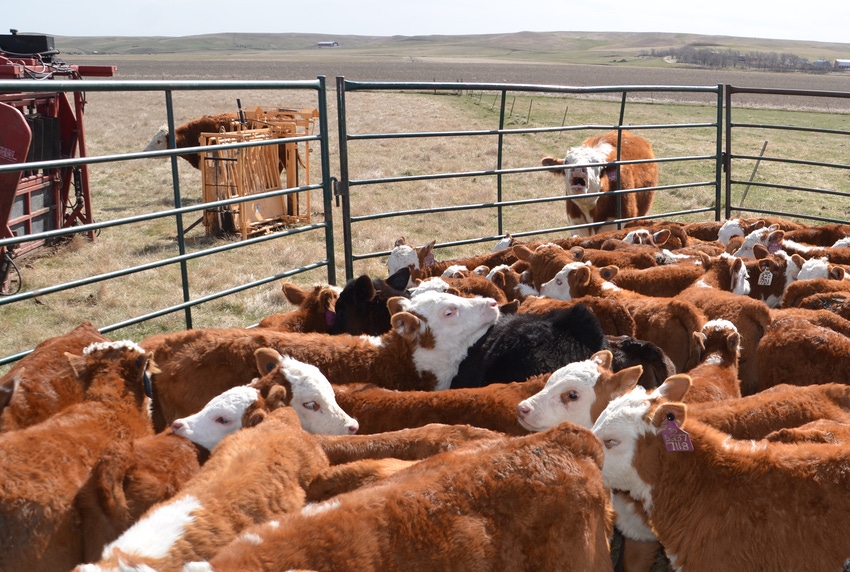5 strategies to reach the weaning finish line
When considering how to wean your calves, no matter what choice you make, minimizing an animal’s stress will keep the process as fluid as possible.
September 20, 2018

By Bruce Derksen
As fall approaches so does the need for many producers to wean their calf crops. Although most practice the same method they have used in the past, the possibility of change should never be dismissed as a slight modification in the usual tactics could bring potential financial rewards.
Some producers may not have flexibility when it comes to weaning strategy, as their infrastructure and financial status might not allow an option that is costlier and more work- and time-intensive. But beef producers do have numerous routes to the finish line of weaned calves and that said finish line is always the same place—healthy, productive calves in your own or someone else’s pens or feedlot.
The main ingredient to create a healthy, efficiently growing and gaining calf post-weaning is to limit stress as much as possible, as it is undeniable that stress creates health issues. When considering how to wean your calves, no matter what choice you make, minimizing an animal’s stress will keep the process as fluid as possible.
There are several options when weaning your calves, from abrupt truck weaning after stripping the calves from the cows, traditional or drylot weaning, pasture weaning, fenceline or two-stage weaning. Each one offers various pros and cons that may convince you to either stay the course or venture into untried territories that might fit your operation better.
Truck weaning is just as it sounds—pulling your calves from their mothers, loading them onto trucks and shipping them off to a feedlot or auction barn. A positive for this option is the lack of infrastructure required such as extra pasture or drylot pens, plus the calves will become someone else’s responsibility usually at the end of a single day.
Adding a slightly more labor-intensive step in this strategy, calves can be vaccinated and scheduled for sale at a preconditioning auction, as many feedlots pay more for large groups of green calves.
A downfall of this option is the lack of flexibility. Once the calves are weaned there is no room for second thoughts. You are committed to moving the calves to market no matter the weather or timing of the auction sales and buyers. Calves will be comingled with other large groups, increasing the risk of disease and possibly bringing down potential prices.
Traditional or drylot weaning is the most commonly practiced method, as it is accepted to be the most price beneficial long term as well as seamless for retained ownership cattle. The calves may encounter an initial period of sickness, but will move into a positive weight gain cycle with the help of a proper backgrounding diet.
They can be easily observed, treated as necessary and offer the flexibility of marketing at almost any time if desired. Obvious negatives are the need for the infrastructure and utilities to house them, plus the manpower to monitor their health and administer medical treatments.
There can also be a risk that the effects of excessive heat, dusty pens, bawling, dehydration, feed change and stress of separation can depress their immune systems to a larger degree and invite longer than normal periods of sickness; only this time, under your watch.
Pasture weaning is an option that can be less stressful, as the calves are left in familiar conditions and pastures as the mothers are moved away. Studies by New Mexico State University show that pasture-weaned calves had larger average daily gains than drylot-weaned calves for the first three weeks after weaning.
These gains leveled off over the subsequent three weeks with the drylot calves eventually surpassing them. This option can be less stressful overall for the calves but, depending on infrastructure, can be more complicated when it comes to treating sick animals.
Derek Haley, a veterinarian and assistant professor at the Ontario Veterinary College in Guelph, conducted research into fenceline weaning with cows and calves separated by a secure fence allowing the calves to see, hear and sense their mother’s presence while not being able to suckle. He found that these calves vocalized 50% less, walked less and had higher weight gains in the first 10 weeks after separation than abruptly weaned calves. A potentially costly secure plank or multi-wired, electric fence is needed for this option.
Another system gaining momentum uses a nose flap or tag placed on the calves at the time of weaning, allowing for grazing and drinking water but interfering with the suckling the dam. These flaps are left on the calves for four to five days and then removed as they are weaned from the cows.
Further research by Haley found these two-stage weaned calves vocalized 97% less, spent 30% more time eating, and walked 45 fewer miles than their abruptly weaned counterparts. In addition, a side benefit was the dams of the two-stage weaning calves vocalized 84% less as well.
Negative aspects of this strategy are that the calves need to be handled twice to install and remove the nose flaps. If they become dislodged or lost, the process of weaning individual calves may have to be restarted.
No matter what option you choose for your infrastructure, time and manpower resources, limit the stress delivered to the calves to allow them to reach the weaning finish line as quickly and efficiently as possible. If you can accomplish this, your calves’ chances at good health and a positive productive outcome will greatly improve.
Derksen is a freelance writer and feedyard pen rider in Lacombe, Alberta, Canada
You May Also Like


.png?width=300&auto=webp&quality=80&disable=upscale)
